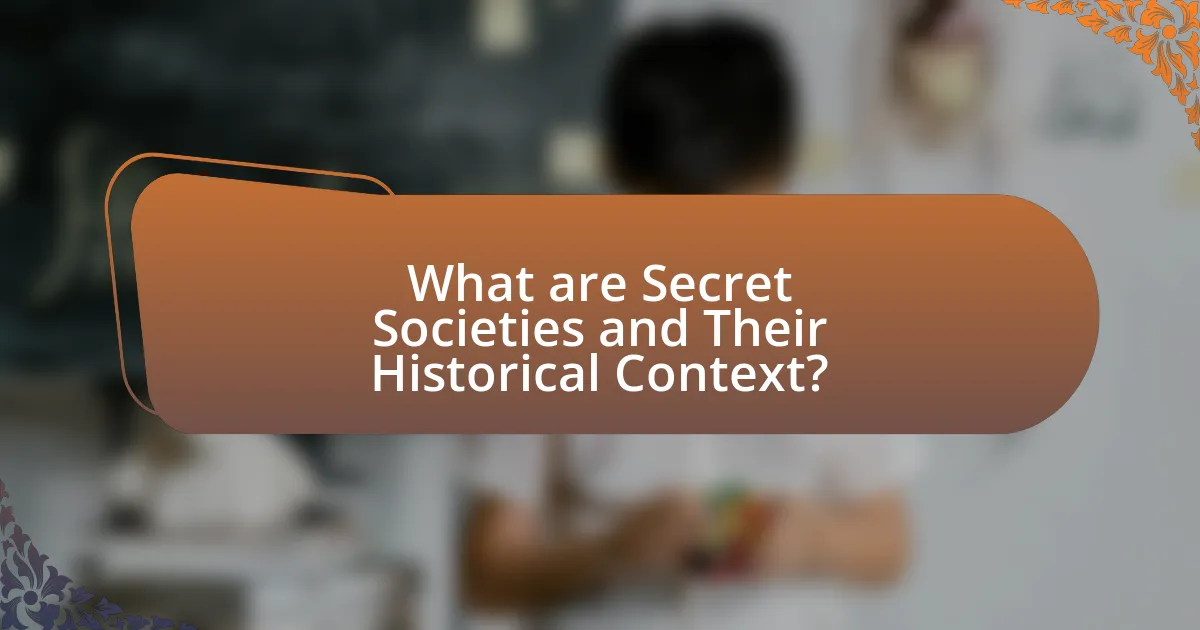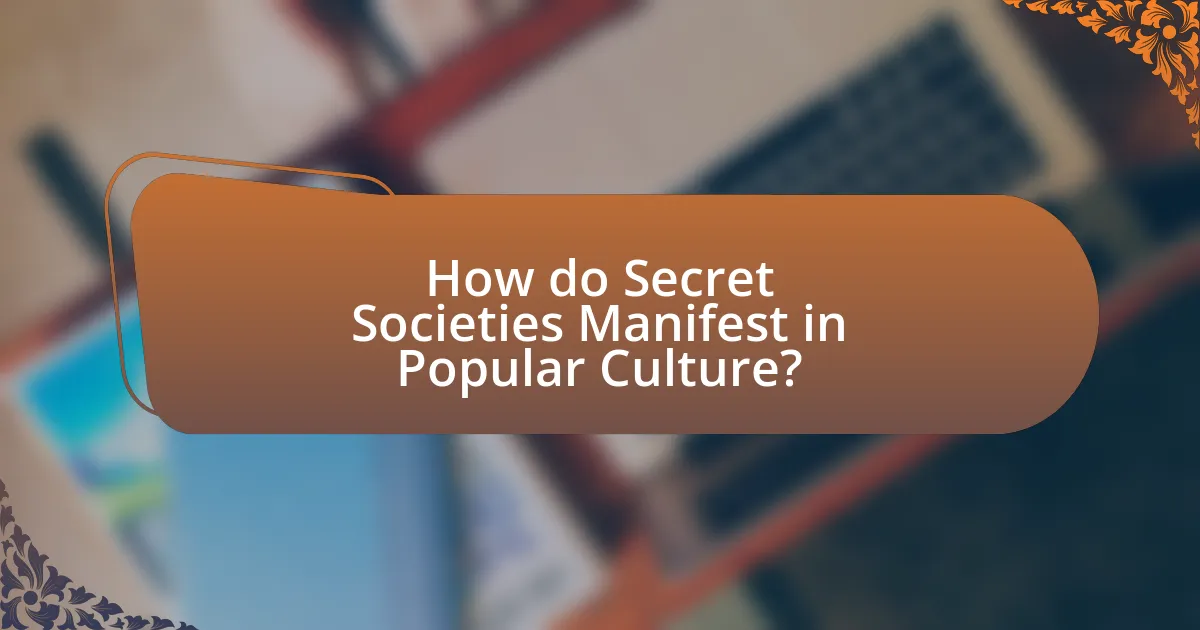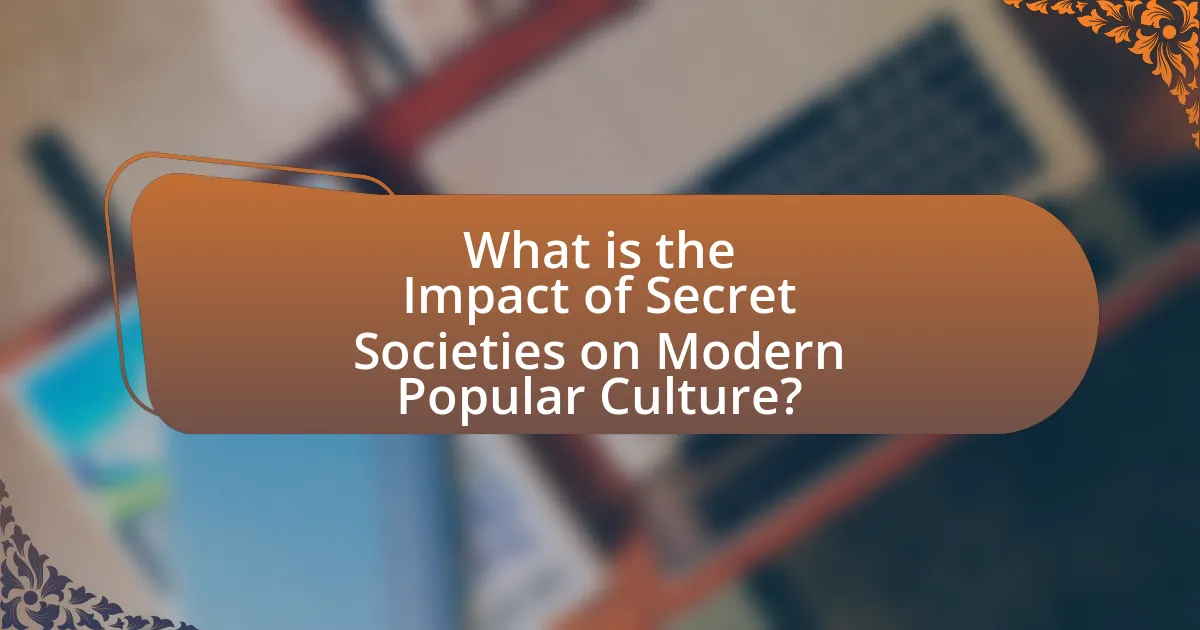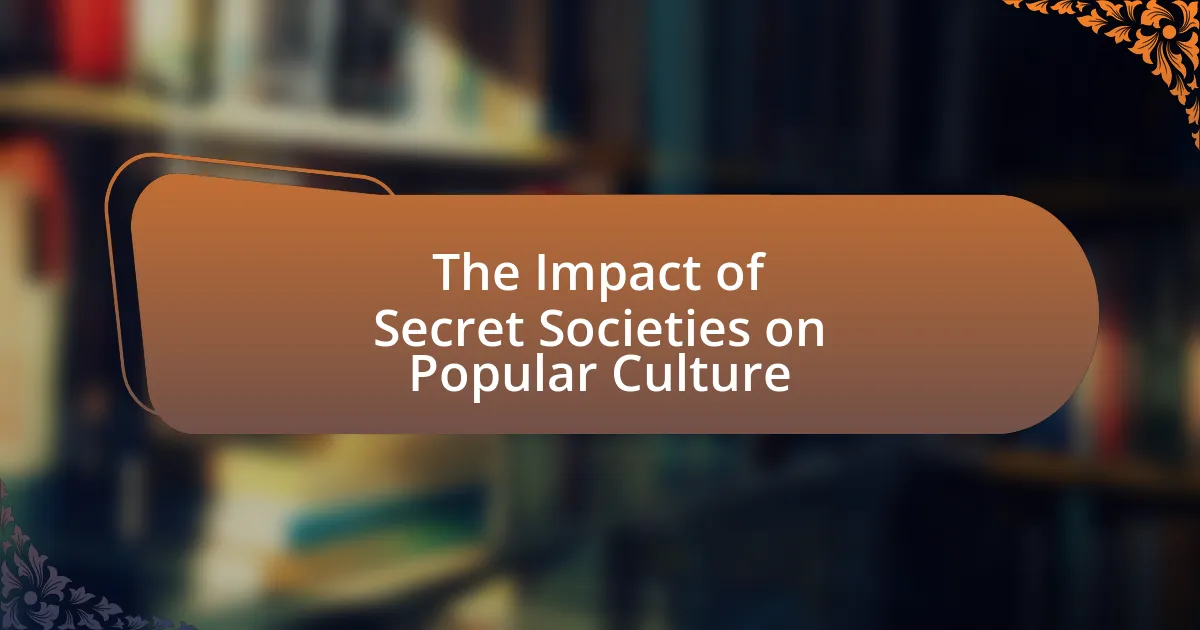Secret societies are clandestine organizations characterized by exclusive membership, rituals, and shared ideologies, often emerging in response to social, political, or religious oppression. Their historical influence is notable, with groups like the Freemasons and the Illuminati playing significant roles in events such as the American Revolution. This article explores how secret societies have shaped historical events, their common characteristics, and the rituals and symbols associated with them. Additionally, it examines their representation in popular culture, including literature, film, and music, highlighting the themes of secrecy, power dynamics, and societal critique that resonate with audiences today. The impact of conspiracy theories related to these societies on public perception and social movements is also discussed, providing insights into their ongoing relevance in contemporary culture.

What are Secret Societies and Their Historical Context?
Secret societies are clandestine organizations that often operate under a veil of secrecy, typically characterized by exclusive membership, rituals, and a shared ideology. Historically, these societies have emerged in various cultures, often in response to social, political, or religious oppression, such as the Freemasons in the 18th century, which sought to promote Enlightenment ideals amidst authoritarian regimes. Their influence can be seen in significant historical events, such as the American Revolution, where members played pivotal roles in advocating for independence. The existence of these societies has sparked intrigue and speculation, contributing to their portrayal in popular culture, where they are often depicted as powerful entities manipulating world events.
How have secret societies influenced historical events?
Secret societies have significantly influenced historical events by shaping political landscapes, promoting revolutionary ideas, and facilitating social change. For instance, the Freemasons played a crucial role in the American Revolution, with many founding fathers, including George Washington and Benjamin Franklin, being members. Their principles of liberty and equality helped inspire the push for independence from British rule. Additionally, the Illuminati, founded in 1776, aimed to promote Enlightenment ideals and counteract religious and political oppression, influencing various revolutionary movements across Europe. These societies often operated in secrecy, allowing them to mobilize support and coordinate actions that led to substantial shifts in governance and societal norms.
What notable secret societies have shaped history?
Notable secret societies that have shaped history include the Freemasons, the Illuminati, and the Rosicrucians. The Freemasons, established in the late 16th to early 17th century, have influenced political and social structures, with members including prominent figures like George Washington and Benjamin Franklin. The Illuminati, founded in 1776 in Bavaria, aimed to promote Enlightenment ideals and has been linked to various conspiracy theories regarding its influence on global events. The Rosicrucians, originating in the early 17th century, focused on esoteric knowledge and have impacted philosophical and spiritual movements. Each of these societies has left a significant mark on cultural and political landscapes throughout history.
How did the secrecy of these societies impact their influence?
The secrecy of these societies significantly enhanced their influence by creating an aura of mystery and exclusivity that attracted public interest and speculation. This intrigue often led to heightened perceptions of power and authority, as seen in historical examples like the Freemasons and the Illuminati, where their clandestine operations fueled conspiracy theories and cultural narratives. Such narratives have permeated literature, film, and art, reinforcing the societies’ mystique and allowing them to shape popular culture by becoming symbols of hidden knowledge and elite control. The combination of secrecy and the resulting fascination has allowed these societies to maintain a lasting impact on societal beliefs and cultural expressions.
What are the common characteristics of secret societies?
Common characteristics of secret societies include exclusivity, secrecy, and a hierarchical structure. Exclusivity is evident as membership is often limited to select individuals, creating a sense of privilege and belonging. Secrecy is a defining trait, with members typically required to keep the society’s activities, rituals, and knowledge confidential. Hierarchical structure is present, as many secret societies have defined ranks or roles, which can dictate the flow of information and power within the group. Historical examples, such as the Freemasons and the Illuminati, illustrate these characteristics, as both organizations have maintained strict membership criteria, conducted secretive meetings, and established internal hierarchies to manage their operations.
What rituals and symbols are associated with secret societies?
Rituals and symbols associated with secret societies include initiation ceremonies, oaths of secrecy, and specific emblems like the skull and crossbones or the all-seeing eye. Initiation ceremonies often involve elaborate rites that signify the transition into a new status within the society, reinforcing loyalty and commitment. Oaths of secrecy bind members to confidentiality, ensuring that the society’s inner workings remain hidden from outsiders. Symbols such as the skull and crossbones, used by groups like the Freemasons, represent mortality and the importance of life choices, while the all-seeing eye symbolizes divine providence and the watchful nature of the society. These elements serve to create a sense of identity and belonging among members, while also contributing to the mystique surrounding secret societies in popular culture.
How do membership and initiation processes vary among secret societies?
Membership and initiation processes among secret societies vary significantly based on the organization’s traditions, goals, and cultural context. For instance, Freemasonry requires candidates to undergo a series of degrees, each involving specific rituals and moral teachings, while the Skull and Bones society at Yale University utilizes a more exclusive and informal selection process, often based on social connections and academic achievement. Additionally, some societies, like the Rosicrucians, emphasize esoteric knowledge and personal transformation as part of their initiation, contrasting with others that may focus on loyalty oaths and secrecy. These variations reflect the diverse purposes and philosophies of secret societies, influencing their cultural impact and representation in popular media.

How do Secret Societies Manifest in Popular Culture?
Secret societies manifest in popular culture through various mediums such as literature, film, and television, often depicted as mysterious organizations with hidden agendas. For example, Dan Brown’s novel “The Da Vinci Code” explores themes of secret societies like the Priory of Sion, influencing public perception and sparking interest in historical conspiracies. Additionally, films like “Eyes Wide Shut” portray elite secret gatherings, reinforcing the notion of clandestine power structures. These representations shape societal views, creating intrigue and speculation about the real-life existence and influence of such groups.
What role do secret societies play in literature and film?
Secret societies serve as pivotal plot devices in literature and film, often symbolizing hidden knowledge, power dynamics, and societal critique. These organizations frequently embody themes of secrecy and exclusivity, allowing authors and filmmakers to explore complex narratives involving conspiracy, morality, and the quest for truth. For instance, Dan Brown’s “The Da Vinci Code” utilizes the Priory of Sion to weave a tale of historical intrigue and religious controversy, illustrating how secret societies can drive the narrative forward while engaging audiences with thought-provoking questions about faith and history. Additionally, films like “Eyes Wide Shut” depict secret societies as a means to critique social hierarchies and the human condition, showcasing their role in reflecting societal fears and desires.
Which books and movies prominently feature secret societies?
Books and movies that prominently feature secret societies include “The Da Vinci Code” by Dan Brown and the film “Eyes Wide Shut” directed by Stanley Kubrick. “The Da Vinci Code” explores the secretive Priory of Sion and its historical implications, while “Eyes Wide Shut” delves into a clandestine society engaged in ritualistic activities. Both works illustrate the intrigue and mystery surrounding secret societies, reflecting their impact on popular culture through themes of conspiracy and hidden knowledge.
How do these portrayals reflect societal views on secrecy?
Portrayals of secret societies in popular culture reflect societal views on secrecy by illustrating a deep-seated fascination and suspicion surrounding hidden knowledge and clandestine activities. These representations often depict secrecy as a means of power, suggesting that those who possess hidden information can manipulate events and influence society, as seen in works like “The Da Vinci Code” by Dan Brown, which explores themes of religious secrecy and conspiracy. Furthermore, the portrayal of secret societies often evokes a sense of intrigue and fear, reinforcing the idea that secrecy can harbor both danger and allure, as evidenced by the portrayal of organizations like the Illuminati in various films and literature. This duality in representation highlights societal ambivalence towards secrecy, where it is simultaneously revered for its mystique and criticized for its potential to conceal malevolent intentions.
How are secret societies represented in music and art?
Secret societies are often represented in music and art through symbolism, themes of secrecy, and narratives that explore power dynamics. For instance, artists like Jay-Z and Kanye West incorporate Masonic symbols in their music videos, suggesting hidden knowledge and elite status. Similarly, visual artists such as Salvador Dalí have depicted secretive rituals and esoteric themes, reflecting the allure and mystery surrounding these groups. The use of symbols like the all-seeing eye or pentagrams in various artworks and songs serves to evoke intrigue and provoke thought about the influence of these societies on society and culture.
What themes related to secret societies are prevalent in popular songs?
Themes related to secret societies prevalent in popular songs include conspiracy, power dynamics, and exclusivity. Many artists explore the idea of hidden agendas and the influence of elite groups on society, reflecting a fascination with the unknown. For instance, songs like “Hotel California” by the Eagles and “The Sound of Silence” by Simon & Garfunkel hint at themes of manipulation and societal control, often interpreted as critiques of secretive organizations. Additionally, the imagery of initiation rituals and the allure of belonging to an exclusive group are common, as seen in tracks by artists like Jay-Z and Lana Del Rey, who reference secretive practices and the seductive nature of power. These themes resonate with listeners, tapping into cultural anxieties about transparency and trust in authority.
How do artists use symbolism related to secret societies in their work?
Artists use symbolism related to secret societies in their work to convey hidden meanings and critique societal norms. For example, the use of the all-seeing eye, often associated with the Illuminati, appears in various artworks to suggest themes of surveillance and control. This symbolism can be traced back to historical contexts, such as the incorporation of Masonic symbols in the architecture of significant buildings like the United States Capitol, which reflects the influence of secret societies on national identity. Additionally, contemporary artists like Banksy utilize symbols linked to secret societies to provoke thought and challenge the status quo, demonstrating how these elements serve as a vehicle for social commentary.

What is the Impact of Secret Societies on Modern Popular Culture?
Secret societies significantly influence modern popular culture by shaping narratives in literature, film, and music. Their portrayal often embodies themes of mystery, power, and exclusivity, which resonate with audiences seeking intrigue. For instance, films like “The Da Vinci Code” and series such as “The X-Files” incorporate secret societies as central elements, reflecting societal fascination with hidden knowledge and conspiracies. Additionally, music artists frequently reference secret societies, using them as metaphors for societal critique or personal empowerment, as seen in works by artists like Jay-Z and Beyoncé. This cultural representation underscores the enduring allure of secret societies, highlighting their role in contemporary storytelling and artistic expression.
How do conspiracy theories involving secret societies shape public perception?
Conspiracy theories involving secret societies significantly shape public perception by fostering distrust in institutions and promoting a narrative of hidden control. These theories often suggest that powerful groups manipulate events behind the scenes, leading individuals to question the legitimacy of governments, media, and other authoritative entities. For instance, the belief in the Illuminati as a controlling force has been linked to widespread skepticism about political decisions and societal norms, as evidenced by surveys indicating that a substantial portion of the population believes in such theories. This skepticism can result in increased polarization and a tendency to reject factual information, as seen in the rise of alternative media platforms that propagate these narratives.
What are some prominent conspiracy theories related to secret societies?
Prominent conspiracy theories related to secret societies include the belief that the Illuminati, a purported secret organization, seeks to control world events and establish a New World Order. This theory is often supported by references to influential figures and symbols associated with the Illuminati, such as the Eye of Providence on the U.S. dollar bill. Another significant theory involves the Freemasons, who are alleged to manipulate political and economic systems for their own benefit, with claims of their involvement in major historical events like the American Revolution. Additionally, the Bohemian Grove, a private club for elite men, is often cited in conspiracy theories suggesting that its members engage in occult rituals and make decisions that affect global policies. These theories reflect a broader cultural fascination with the idea that hidden groups exert control over society.
How do these theories influence popular culture narratives?
Theories regarding secret societies significantly influence popular culture narratives by shaping themes of conspiracy, power dynamics, and hidden knowledge. These narratives often depict secret societies as controlling forces behind major historical events, which resonates with audiences seeking to understand complex societal structures. For instance, films like “The Da Vinci Code” and series such as “The X-Files” incorporate elements of secret societies to create suspense and intrigue, reflecting public fascination with the unknown. Additionally, literature and media frequently explore the idea that these groups manipulate reality, reinforcing the notion that there are unseen influences at play in everyday life. This portrayal not only captivates audiences but also encourages critical thinking about authority and transparency in society.
What are the implications of secret societies on social movements?
Secret societies can significantly influence social movements by providing a framework for organization, resource mobilization, and strategic planning. These groups often operate under a veil of secrecy, which can foster a sense of exclusivity and commitment among members, enhancing their ability to coordinate actions and disseminate ideas. For instance, the Freemasons and the Illuminati have historically been linked to various social and political movements, leveraging their networks to promote specific agendas. The impact is evident in the way these societies have shaped public discourse and mobilized support for causes, such as civil rights and political reform, by utilizing clandestine meetings and strategic alliances to amplify their influence.
How have secret societies inspired real-world activism?
Secret societies have inspired real-world activism by providing frameworks for collective action and fostering a sense of community among members. Historical examples include the Freemasons, who played a significant role in the American Revolution by promoting Enlightenment ideals and encouraging political engagement among their members. Additionally, the Illuminati, although often shrouded in myth, has been associated with movements advocating for social change and reform, influencing various activist groups throughout history. The influence of these societies can be seen in the way they have mobilized individuals around common causes, such as civil rights and anti-establishment movements, demonstrating their impact on activism in society.
What lessons can be learned from the influence of secret societies on culture?
The influence of secret societies on culture teaches that these organizations can significantly shape societal norms, values, and artistic expressions. For instance, the Freemasons have historically impacted architecture and literature, evident in the incorporation of Masonic symbols in prominent buildings and works by authors like Dan Brown. Additionally, secret societies often foster a sense of community and exclusivity, which can lead to the creation of subcultures that challenge mainstream ideologies, as seen in the countercultural movements of the 1960s influenced by groups like the Bohemian Club. These examples illustrate how secret societies can serve as catalysts for cultural evolution and social change.
What can individuals learn from the portrayal of secret societies in popular culture?
Individuals can learn about the complexities of power dynamics and social structures from the portrayal of secret societies in popular culture. These representations often highlight themes of exclusivity, manipulation, and the influence of hidden agendas on societal events. For instance, films like “The Da Vinci Code” and series such as “The X-Files” illustrate how secret societies can shape historical narratives and public perception, reflecting real-world concerns about transparency and trust in institutions. Additionally, the depiction of these groups can serve as a cautionary tale about the dangers of secrecy and the potential for corruption, as seen in the portrayal of organizations like the Illuminati in various media. This understanding encourages critical thinking about the information presented in popular culture and its implications for real-life societal issues.
How can understanding secret societies enhance critical thinking about media?
Understanding secret societies can enhance critical thinking about media by revealing the underlying narratives and power dynamics that shape information dissemination. Secret societies often influence cultural and political landscapes, which can lead to biased or manipulated media portrayals. For instance, the role of organizations like the Freemasons or the Illuminati in historical events can illustrate how elite groups may control or sway public perception through media channels. By analyzing these influences, individuals can develop a more discerning approach to media consumption, recognizing potential agendas and questioning the authenticity of the information presented. This critical perspective is essential in an era where misinformation can easily spread, allowing for a more informed and analytical engagement with media content.
What are some best practices for engaging with themes of secrecy in culture?
Best practices for engaging with themes of secrecy in culture include fostering open dialogue, respecting cultural sensitivities, and utilizing storytelling techniques that highlight the complexities of secrecy. Open dialogue encourages diverse perspectives, allowing individuals to share their experiences and interpretations of secrecy, which can lead to a deeper understanding of its cultural significance. Respecting cultural sensitivities is crucial, as secrecy can be tied to identity and heritage; thus, engagement should be approached with care to avoid misrepresentation. Storytelling techniques, such as using metaphors or allegories, can effectively convey the nuances of secrecy, making the theme relatable and thought-provoking. These practices are supported by cultural studies that emphasize the importance of context and representation in understanding secretive practices within societies.
